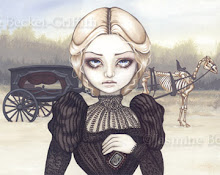 |
| Early mourning ring, made of gold featuring black enamel highlighting the figure of a skeleton. 1779. |
 |
| Brooch featuring grown hair and sepia work depicting a widow weeping over a tomb. Circa 1880 |
 | |||
| Typical Victorian brooch, made of Jet and showing an ornate pattern of initials central to the design. |
It is very easy when writing on this subject to become fixated on the ideals of life and death and the connotations they allure to. I may revisit these notions at a later date, but for the purpose of this blog entry I am content to concentrate purely on the physical aspects of mourning jewellery.
It is in our nature as human beings to will there to be something more to life than simply living and dying, many of us seek comfort in the idea that life continues in some form or another once the physical being ceases to exist. In a sense mourning jewellery provides a tangible example of life and memory continuing. Throughout history human kind has been occupied with the notion of death and the afterlife.
I think one of the underlying reasons why death fascinates us is the fact death is a unifying constant. No matter your colour, creed or class death will always, eventually, find you.
Early mourning jewellery from the 16th century often depicted macabre images of skeletons, death heads and the grim reaper. The verses and dedications accompanying the jewels were usually of a sombre nature often intended as a warning to others, the pieces were fashioned to remind the wearer of the fragility of life and that death is always close, this was quite literally they case. Infant morality rates were high, outbreaks of plague and pestilence were common place and the people were not privy to the medical knowledge that we are today. The jewellery its self was usually fashioned from gold, sometimes featuring hair usually protected by a piece of rock crystal inlayed to the gold. Enamelling in black is often seen as black is strongly associated with mourning customs.
As we move into the 1800s the images of death and decay are replaced with softer, more romantic imagery. This in artistic terms is considered “The age of Enlightenment”. Society saw a dramatic change in ideas and in fashions and this in turn this was reflected in mourning jewellery. No longer were macabre images considered an acceptable way to remember the dead but scenes of a more elegant nature were introduced. The dedications and verses also followed suit and became far more poetic. As before the most popular medium to work was gold, enamelling was also widely used, mainly black but other colours are know for their use to signify different meanings. White enamel was used to show the piece was commemorating the death of an innocent or unmarried individual. Hair belonging to the deceased was also used in many different ways, often in intricate braids and placed under clear crystal coverings. Hair was also woven to form the body of the jewellery and strung to be worn as chains and bracelets. Hair was even finely ground, mixed with sepia and painted onto backgrounds of ivory to form detailed pictures that could be personalised to suit the wears requirements.
During the Victorian era mourning jewellery grew in popularity. This was, in most parts, due to what the public considered fashionable. Queen Victoria’s’ prolonged mourning of her late husband Price Albert saw the fashion for mourning jewellery grow. Victorians were governed by strict customs when it came to mourning the dead, certain etiquettes had to be followed, this included wearing black, and with this sombre jewellery. Jet, a fossilised wood, was an ideal material for use in the making of mourning jewels and with the new age of industrial revolution mourning jewellery was made in a wide scale, commercial sense making it readily available in many different designs that were often personalised to suit the wearers requirements.
The popularity of mourning jewellery saw a sharp decline after WW1. The country had suffered a great deal of loss and there was a longing to move away from customs of old. The great war changed social views and brought about changes in the class system. Mourning jewellery became an unfavourable relic of a bygone era.
In today’s modern society mourning jewellery is often thought of as a morbid subject, I have had many odd looks and whispered comments when I have, on occasion, admitted to my passion. So much so, when asked my speciality in the jewellery trade I tend to mumble something along the lines of;
“oh, erm, *coughs* sentimental jewels and the like.”
Not only to shave my blushes, but to save the questioner a need to fain interest. There are collectors in varying fields of mourning, but taboos and modern day misconceptions about death really prohibit lengthy discussions about mourning jewellery in the workplace.
Of course, the subject of mourning jewellery cannot be adequately summed up in a “brief history”, what is written here is merely a very scant overview. In later blog posts I planned to delve into key eras in more depth, hopefully you will join me.
As always it has been a pleasure,
MM x

It is interesting that you mention a sharp decline in mourning jewellery after the Great War. During the war many of those Victorian customs were adhered to; memorial cards, closing of one's curtains &c. Is there a link between the fact that the IWGC gave each of the fallen men a grave stone and so the need for a tangible focus of mourning, as provided by a piece of jewellery, was replaced. The decline cannot have been purely due to a shift in class consciousness, many other 'bygone' customs remained.
ReplyDeleteA fascinating post and I look forward to you going into more detail on certain periods and pieces in the not too distant future.
Keep up the splendid work.